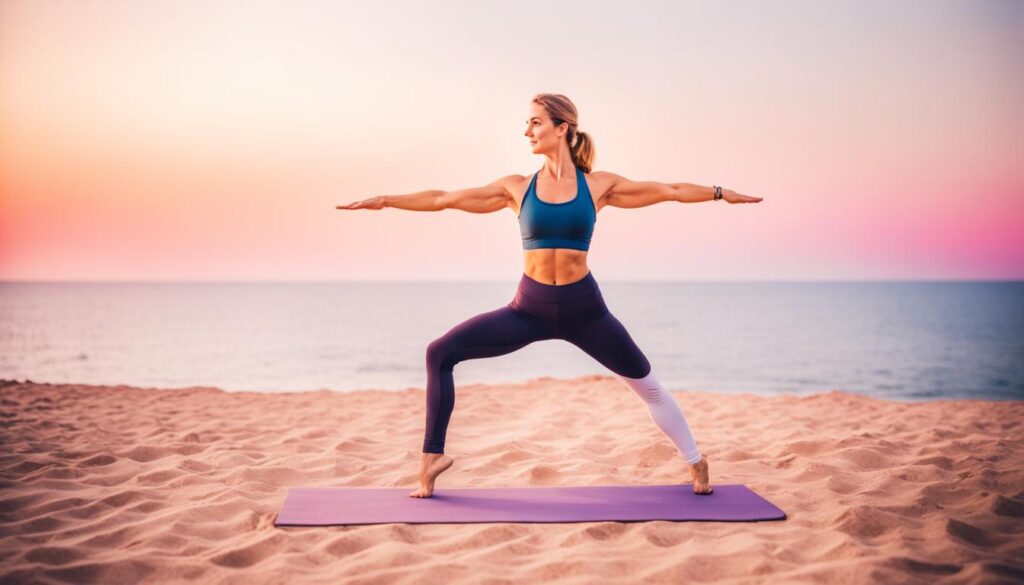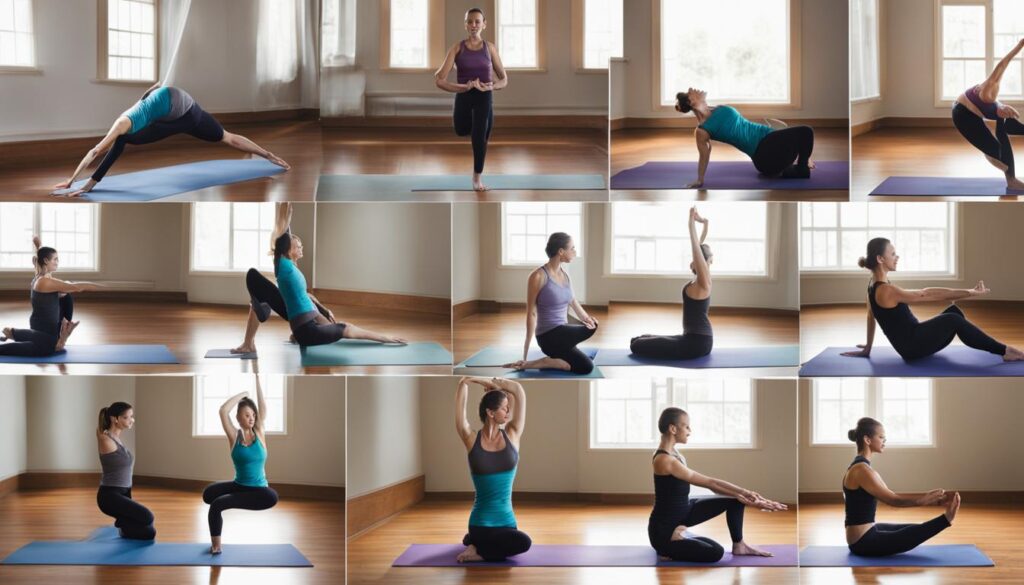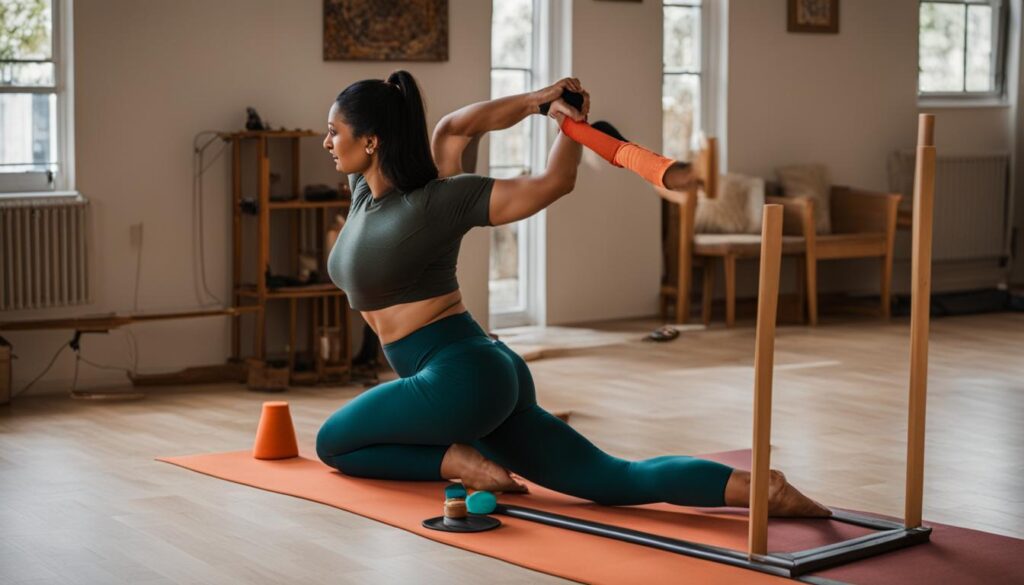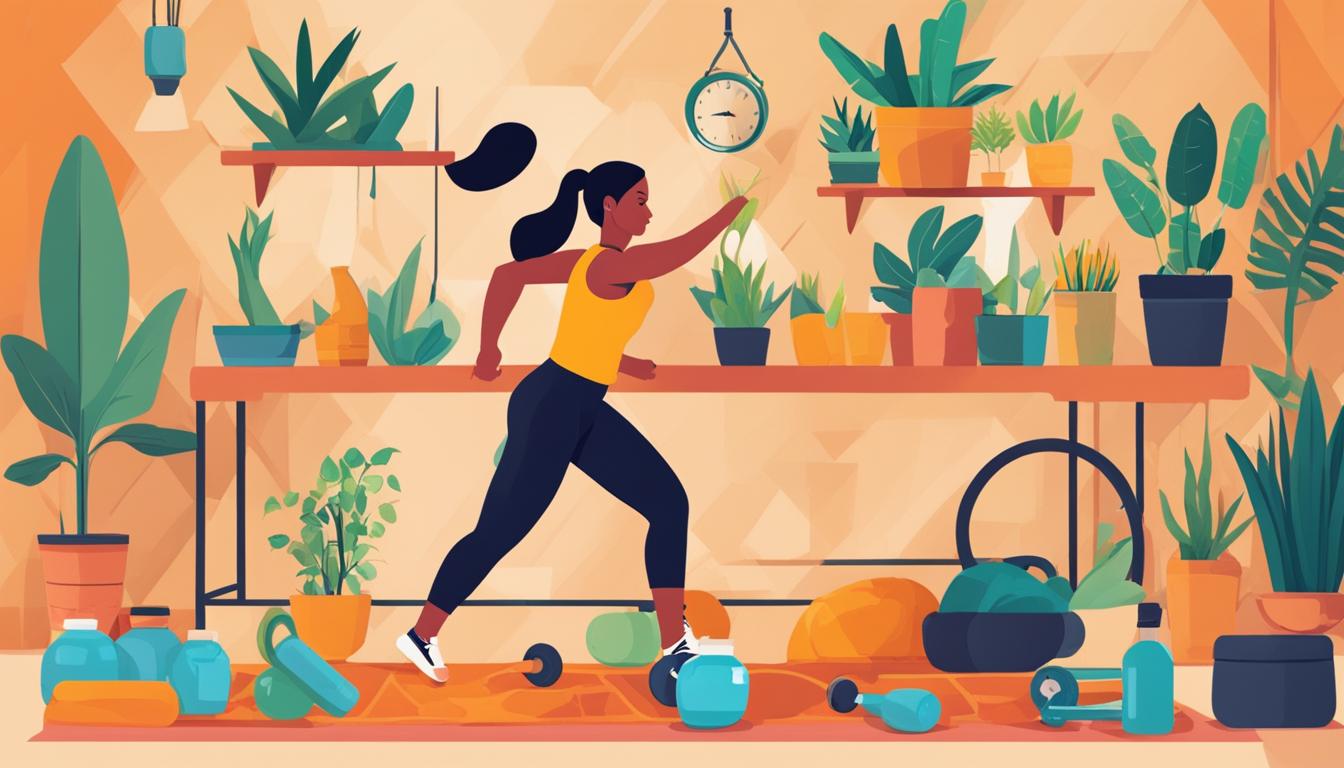Embarking on a wellness endeavour has never been more inviting than with our beginner’s yoga guide. As you unfold your mat and step into a realm of tranquillity and strength, discover how yoga for beginners can reshape your perspective on health. Our specially tailored guide illuminates beginner-friendly yoga poses, ensuring a smooth transition into this ancient practice. Let’s journey together through the essential basic yoga poses for beginners, designed to enhance your physical well-being and serenity from your very first stretch. Embrace these beginner yoga poses as your gateway to a balanced and rejuvenated self.
Key Takeaways
- Grasp the essentials of starting your yoga path through a variety of beginner-friendly poses.
- Learn how basic yoga structures can bolster both your mental peace and physical prowess.
- Explore the physical and mental harmony achievable through beginner yoga practices.
- Delve into the foundational techniques critical to building a sustainable yoga journey.
- Uncover the gentle, yet profound influence of yoga on cultivating balance in everyday life.
Understanding Yoga: A Holistic Approach to Well-being
Discovering the essence of yoga is akin to embarking on a journey that has thrived through the ages, evolving into a practice that transcends physical agility to encompass a route to holistic health. For those just starting with essential yoga poses for beginners, it’s an invitation to a life enriched by yoga’s mental well-being and a celebration of the capability inherent in every body type. Yoga’s historical significance informs its present, making modern yoga practice a reflection of a time-tested tradition.
Historical Significance and Modern Adaptations
The historical roots of yoga spread deep into the past, shaping a legacy that has been carried down through generations to arrive at our modern yoga practice. Understanding this history enriches the experience of yoga poses for beginners, providing a solid foundation for growth. As we navigate through its rich tapestry, we find that the versatility of yoga has allowed it to stand the test of time, adapting deftly to the changing landscapes of societal needs and fitness trends.
The Physical and Mental Health Benefits of Yoga
Among the many treasures yoga offers are its holistic health benefits, impacting the entirety of the practitioner’s well-being. From enhancing flexibility to building muscle strength, each pose is a step towards physical vitality. Yet, yoga’s influence extends beyond the body, into the realms of the mind and spirit. Stress relief, improved mental health, and increased resilience against common ailments stand as testaments to the power of a consistent yoga practice.
Yoga’s Accessibility for All Body Types
Immersing in the practice of yoga reveals a transformative truth: it truly is a practice for every body type. Whether you are in the dawn of youth or the golden years of wisdom, whether athletically inclined or new to the concept of exercise, the inclusivity of yoga welcomes you with open arms. Emphasizing adaptability and self-acceptance, yoga serves as a gentle reminder that the journey is a personal one, and each asana can be modified to embrace individual needs.
The Foundations of Yoga Practice
Embarking on your yoga journey, you’re about to explore the profound union of movement and breath, the yoga fundamentals that have paved the way for countless practitioners. As you embrace a beginner’s yoga sequence, remember, it’s not about perfection; it’s about progression. Acknowledge your starting point, approach each session with an open mind, and watch as your practice evolves.
Mindfulness is the cornerstone of yoga. It encourages you to be present and patient with your body’s capabilities as you learn. Begin with beginner-friendly yoga poses, understanding that these fundamental asanas are the building blocks of all future practices. Balancing strength and flexibility, these poses lay the groundwork for a transformative personal journey within the world of yoga.
Yoga is not about touching your toes, it’s about what you learn on the way down.
Take a look at this specially curated table, visualizing some primary poses that are excellent for beginners. Remember, consistency is key; with regular practice, these poses will become the foundation from which you can expand into more intricate and challenging sequences.
| Yoga Pose | Description | Benefits |
|---|---|---|
| Mountain Pose (Tadasana) | The foundation of all standing poses; improves posture. | Strengthens thighs, knees, and ankles; firms abdomen and buttocks. |
| Warrior I (Virabhadrasana I) | A powerful standing pose that builds focus, power, and stability. | Enhances strength and flexibility in legs and hips; stimulates abdominal organs. |
| Downward-Facing Dog (Adho Mukha Svanasana) | An all-encompassing stretch that rejuvenates the entire body. | Promotes spinal and digestive health; strengthens arms, shoulders, and legs. |
| Tree Pose (Vrikshasana) | A pose that encourages balance and a deep connection to the earth. | Strengthens legs; improves proprioception and equilibrium. |
| Child’s Pose (Balasana) | A gentle resting pose that calms the mind and relaxes the body. | Relieves neck and back tension; stretches hips, thighs, and ankles. |
Guidance from experienced yoga instructors can amplify your experience, offering personalized adjustments and insights. As you engage with each pose, listen to your body’s intuitive cues and respect its limits. Remember, every yogi started as a beginner, and the journey itself is enriching and full of discovery. Stick with it, and you’ll be rewarded with a lifelong companion for wellness and inner peace.
Curating Your Comfortable Space for Yoga
As you begin to explore easy yoga poses for beginners, the importance of creating a serene yoga practice environment cannot be overstated. This sanctuary will not only house your physical practice but also support the mental and spiritual aspects of your yoga journey. Let’s delve into how to curate this space with essential yoga mats and clothing, as well as beginner-friendly yoga props.
Choosing the Right Gear: Mats, Clothing, and Props
Finding the right gear is crucial to your comfort and success in yoga. A quality yoga mat with the right texture, thickness, and material will offer you the stability and cushioning you need. When it comes to yoga mats and clothing, prioritize functionality and personal comfort. Comfortable, breathable attire will allow for a range of movement and enhance the experience of each pose. For novices, utilizing yoga props for beginners can facilitate easier access to poses and improve alignment without strain.
| Item | Description | Benefits |
|---|---|---|
| Yoga Mat | A non-slip surface designed for stability and cushioning. | Prevents slipping, and provides comfort for joints and backs during poses. |
| Yoga Clothing | Breathable, flexible apparel including leggings, tops, and supportive undergarments. | Ensures unrestricted movement and helps to maintain a comfortable body temperature. |
| Yoga Blocks | Foam or cork supports that aid in balance and alignment. | Helps beginners perform poses more comfortably and safely, enhancing alignment. |
| Yoga Straps | Bands that extend the reach and improve form in poses. | Assists with stretching and achieving proper pose alignment without strain. |
Creating an Ambient and Distraction-Free Environment
To fully immerse yourself in your yoga practice, it’s essential to carve out a peaceful corner that is free from distractions. This could be a designated room or a quiet space in your home with soft lighting and perhaps some calming scents or music. The goal is to create an ambient atmosphere that allows you to focus internally and cultivate a deep connection with your practice.
Remember, your yoga space is a reflection of your personal journey. It should resonate with what you seek from your practice, whether it’s peace, strength, or clarity. With the right yoga mats and clothing, complemented by supportive yoga props for beginners, you’ll be well-equipped to embark on a fulfilling yoga journey right in the comfort of your own curated space.
Beginners’ Guide to Yoga Poses
As you delve into the world of yoga, familiarizing yourself with beginner-friendly asanas is crucial for a solid foundation. Let’s explore some fundamental poses that will catalyze your journey towards enhanced well-being.

Mountain Pose (Tadasana): A Pose for Posture and Stability
Tadasana, or Mountain Pose, forms the bedrock of all standing poses in yoga. By practicing Tadasana, you initiate a connection with the earth, stabilize your base, and cultivate a sense of grounding necessary for a centered yoga practice.
Downward-Facing Dog (Adho Mukha Svanasana): Stretching and Strengthening
Adho Mukha Svanasana stretches the hamstrings, spine, and calves, while strengthening your arms, shoulders, and back. This rejuvenating inversion is pivotal for building overall body strength.
Tree Pose (Vrikshasana): Cultivating Balance and Concentration
In Vrikshasana, or Tree Pose, you’ll discover a harmonious blend of balance and concentration. This poses challenges you to root firmly into the ground, promoting stability in your physical and mental presence.
Cat-Cow Pose (Marjaryasana-Bitilasana): Flexibility for the Spine
The rhythmic flow between Marjaryasana and Bitilasana improves flexibility in the spine, stimulates abdominal organs and sets a serene tone for your practice with its soothing motion.
Child’s Pose (Balasana): Relaxation and Stress Relief
Balasana is a humble yet profound pose that promotes relaxation and stretches the hips, thighs, and ankles. It allows for a moment of reprieve, offering deep relief from any tension built up during your practice.
| Yoga Pose | Benefits | Focus Area |
|---|---|---|
| Tadasana (Mountain Pose) | Improves posture, enhances stability | Legs, core, spine |
| Adho Mukha Svanasana (Downward-Facing Dog) | Stretches the body, strengthens muscles | Arms, shoulders, hamstrings, calves |
| Vrikshasana (Tree Pose) | Builds balance, enhances concentration | Legs, core, mental focus |
| Marjaryasana-Bitilasana (Cat-Cow Pose) | Increases spinal flexibility, relaxes the mind | Spine, abdomen |
| Balasana (Child’s Pose) | Promotes relaxation, deepens stress relief | Hips, thighs, ankles |
Embarking on beginner yoga poses like Tadasana, Adho Mukha Svanasana, Vrikshasana, Marjaryasana-Bitilasana, and Balasana is your first step toward a fulfilling and balanced yoga practice. Embrace each pose with an open heart and allow yourself the space to grow both on and off the mat.
Incorporating Breathwork into Your Practice
As you delve deeper into yoga, understanding the vital role of breathwork is key to enriching your practice. Pranayama for beginners can start with straightforward techniques that fuse yoga and breathwork to create a harmonious balance between the body and mind. While mastering breathing techniques in yoga, you’ll notice a significant enhancement in your ability to stay present and connected throughout your sessions.
Understanding the Role of Pranayama
At the heart of a robust yoga routine lies Pranayama, a Sanskrit term that captures the essence of life energy regulation through controlled breathing. Pranayama goes beyond mere breath control; it is an art form that, when practised with intention, can lead to improved mental focus, a fortified immune system, and a sense of inner peace.
Simple Breathing Techniques for Beginners
Embarking on the journey of Pranayama doesn’t require you to be an adept yogi. Even as a newcomer, you can adopt simple yet effective breathing techniques in yoga that will lay the groundwork for a transformative practice. Below is a fundamental exercise you can try:
- Begin in a comfortable seated position, with your spine straight and your hands relaxed on your knees.
- Close your eyes gently and bring your attention to your natural breathing pattern.
- Take a slow, deep inhalation through your nose, feeling your chest and abdomen expand.
- Hold your breath for a moment at the peak of your inhalation.
- Exhale slowly and completely, noticing the release of tension from your body.
- Repeat this full yogic breath for 5-10 cycles, each time delving a bit deeper into the experience.
This foundational practice is aptly named the full yogic breath, and it’s an excellent starting point for Pranayama for beginners. By including it in your daily yoga and breathwork routine, you’ll begin to understand how each breath is a step toward a more centred and serene state of being.
The Link Between Yoga and Stress Reduction
Have you ever felt overwhelmed by the stresses of daily life? You’re not alone. But there’s good news: yoga’s stress relief benefits are a natural antidote to the pressures that wear us down. When you unroll your yoga mat, you’re not just stepping into a space for physical exercise; you are entering a sanctuary for your mind. Let’s dive into how yoga for reducing anxiety can transform stress into serenity.
Yoga is far more than just bending and stretching. It integrates physical postures with breathing techniques and meditation, creating a multifaceted approach that addresses stress on multiple levels. Regular yoga practice leads to a remarkable state of relaxation, which, in turn, reduces the body’s stress responses. You learn to quiet your mind, leading to a profound calm that permeates your entire being.
Studies confirm that the integrative approach of yoga can lead to significant reductions in stress and anxiety levels, thereby enhancing psychological well-being and overall quality of life. Through discipline and regular practice, yoga offers a sustainable path to balance and tranquility.
Below is a breakdown of the components of yoga that contribute to its stress-relieving properties:
| Yoga Component | Stress-Relief Benefits |
|---|---|
| Grounding Poses | Enhances stability and presents a calming foundation |
| Mindful Breathing (Pranayama) | Reduces the stress hormone cortisol, calming the mind |
| Meditative Focus | Shifts attention away from stressors, inducing peace |
| Physical Activity | Releases endorphins, boosting mood and relaxation |
Perhaps you’re considering making yoga a part of your routine. Remember, the benefits of yoga extend beyond temporary relief. With consistent practice, you can forge a powerful tool that strengthens your resilience against the anxieties of life. So take comfort in knowing that peace is just a pose away.
- Connect with your breath.
- Strike a pose and feel the earth support you.
- Embrace the calming rhythm of mindful movement.
In your journey towards stress management and mental well-being, let yoga be your guide. By integrating these practices into your life, you’ll discover that the serenity you seek is within your reach, one stretch, one breath at a time.
Building Strength and Flexibility with Yoga
Embarking on a yoga journey often starts with the quest for flexibility and strength. However, many novices hold onto the yoga misconception that they must already be flexible to start practising. Let’s debunk this myth and explore how yoga for strength and flexibility truly works for everyone.
The Misconception of Flexibility as a Prerequisite
It’s a common fallacy that one needs to be bendy as a rubber band to practice yoga. Yet the reality is quite the opposite. Yoga is a journey, and flexibility is one of its destinations, not the starting point. Through consistency and patience, your yoga practice will enhance your natural flexibility over time.
Strength-Building Asanas for Beginners
Yoga is about balance, and it offers just as many opportunities for building strength as it does for flexibility. Here are some strength-building yoga poses that help you fortify your body while improving flexibility as you ease into your yoga practice.
| Yoga Pose | Target Areas | Strength Benefits | Flexibility Benefits |
|---|---|---|---|
| Plank Pose | Chest, Shoulders, Core | Builds endurance and core stability | Stretches the spine; promotes posture |
| Chair Pose | Thighs, Glutes, Core | Increases lower body strength | Opens the chest and shoulders |
| Warrior II | Legs, Core, Arms | Tones legs and arms; increases stamina | Improves hip flexibility and balance |
| Chaturanga | Arms, Wrists, Abdominal | Enhances arm and wrist strength | Expands chest; builds resilience |
| Boat Pose | Core, Hip Flexors | Strengthens the core muscles | Stretches the hamstrings |
Incorporating these poses into your routine not only paves the way for a more flexible body but also sets the foundation for increased muscular strength. Remember, in yoga, the balance between strength and flexibility creates a harmonious, powerful, and capable physique—accessible to you from day one. So, let go of the belief that you must be flexible to start; instead, take pride in the strength and suppleness you’ll gain with your practice. Your yoga journey starts now, perfect as it is.
The Significance of Yoga Sequencing for Beginners
Embarking on a beginner’s yoga sequence is much like discovering the rhythm in a dance—it’s about understanding the flow from one movement to the next. As you uncover the subtle art of yoga pose progression, your body and mind engage harmoniously, allowing you to reap the full benefits of each practice.
Think of sequencing as the road map of your practice. Starting with gentle warm-up poses primes your muscles and joints, gradually moving towards more challenging asanas which test your strength and flexibility, before winding down with restorative postures that relax and integrate your entire system.

It’s critical to approach your sequence with intention, ensuring your body is both opened and strengthened in a safe, balanced manner. Here’s a basic structure to help guide your sessions:
- Begin with grounding and breath-awareness exercises to establish a foundation.
- Transition into warming poses to raise your body’s temperature and prepare for movement.
- Engage in a series of standing poses that build strength and stability.
- Practice balance poses to refine focus and coordination.
- Advance to peak poses that challenge your limits and enhance vitality.
- Conclude with cooling poses leading into deep relaxation.
Below, you’ll find a beginner-friendly sequence that gently leads you through the yoga pose progression.
| Stage | Focus | Poses |
|---|---|---|
| Grounding | Breath and Awareness | Seated Meditation, Easy Pose (Sukhasana) |
| Warm-up | Flexibility & Circulation | Neck Stretches, Shoulder Rolls, Cat-Cow Pose (Marjaryasana-Bitilasana) |
| Standing Poses | Strength & Stability | Mountain Pose (Tadasana), Warrior II (Virabhadrasana II) |
| Balance | Focus & Coordination | Tree Pose (Vrikshasana) |
| Peak Poses | Endurance & Vitality | Extended Triangle Pose (Utthita Trikonasana), Bridge Pose (Setu Bandhasana) |
| Cooling Down | Relaxation & Integration | Seated Forward Bend (Paschimottanasana), Corpse Pose (Savasana) |
Remember, your yoga sequence is not just a set of physical instructions; it’s an intimate dance with your inner self. As you practice, listen patiently to your body, allowing it to guide you through these stages, ensuring a supportive practice, nurturing, and most importantly, enriching your beginner’s journey.
Exploring Varieties of Yoga: Finding Your Preferred Style
Finding your yoga style is an exciting part of starting your practice. As you search for types of yoga for beginners, remember that each style offers a unique experience tailored to different needs and goals. With options ranging from the calm, restorative sessions to more physically demanding styles, there’s a practice suited for everyone. Here’s a look at various yoga types to help you find your fit.
Consider what you want to achieve through yoga. Are you looking for a means to unwind and de-stress, or are you aiming for a more intense physical workout? Maybe you’re interested in the spiritual and meditative aspects of the practice. Regardless of your goals, there’s a yoga style out there waiting for you to unfurl your mat and join in.
| Yoga Style | Primary Focus | Best For |
|---|---|---|
| Hatha Yoga | Foundation of yoga poses (asanas) | Beginners seeking a thorough introduction to yoga basics |
| Vinyasa Flow | Smooth transition between poses | Those who enjoy a rhythmic practice that combines movement with breath |
| Iyengar Yoga | Precision and alignment | Practitioners looking to fine-tune their poses with detailed guidance |
| Ashtanga Yoga | Strength and endurance | Individuals looking for a more physically demanding and structured sequence |
| Bikram Yoga | Intense heat and sweat-inducing practice | Those who want a challenging workout in a hot environment |
| Kundalini Yoga | Spiritual growth and energy work | Seekers of a deeper, more introspective experience focusing on the spine and awakening energy |
| Restorative Yoga | Relaxation and healing | Individuals in need of stress relief and gentle recovery |
| Yin Yoga | Deep tissue and flexibility | Those who want to improve flexibility with slow, prolonged holds |
Experiment with different classes to get a feel for each style. Pay attention to how each one makes you feel during and after the practice. Remember, the best type of yoga for you is the one that you enjoy and will stick with. Your yoga journey is a personal exploration—trust your intuition and let it guide you towards the practice that feels right for you.
Adapting Yoga Poses for Individual Needs
Yoga is a practice that honours the individuality of each person. Recognizing that every yogi has unique abilities and limitations, adapting yoga asanas for personal comfort and physical capability is a cornerstone of this inclusive discipline. Whether you’re a beginner or seasoned practitioner, learning to modify yoga poses can enrich your practice, enabling a deeper connection with your body’s needs.
Modifications to Enhance Comfort and Stability
When engaging in yoga, it’s crucial to ensure that each yoga pose serves your body effectively. By making small adjustments, you can experience the essence of the asana without strain or discomfort. For example, a simple yoga pose modification like bending your knees slightly in a forward fold can alleviate tension in the lower back and enhance the pose’s stability. Adapting yoga asanas isn’t about ease, but about making each posture work for you, creating a stable foundation for your practice.

Utilizing Props for Proper Alignment and Support
Yoga props are not just aids for beginners; they’re tools that can elevate the practice of yogis at all levels. Blocks, straps, and bolsters can offer the necessary support to maintain proper alignment and prevent injury. For instance, placing a block under your hand in Triangle Pose can help keep your torso properly aligned if you cannot reach the floor comfortably. Through such adaptations, each yogi can access the full benefits of asanas while respecting their body’s current state.
Practicing Mindfulness and Presence in Each Movement
As you unfold your yoga mat and step onto its grounding surface, you embark on a journey that is not only about physical alignment but also about fostering yoga mindfulness. Every posture, and every breath becomes an opportunity to cultivate present-moment awareness in yoga. This awareness transforms your practice from a mere exercise routine to a holistic experience that enriches your body, mind, and soul.
Your breath guides your movement, and with each inhale and exhale, you develop a deeper understanding of your body’s capabilities and limitations. As you flow from one pose to another, allow the focus on your breath to anchor you in the present, the here and now, where true mindfulness resides.
Here’s a short mindfulness exercise to integrate into your yoga practice:
- Assume a comfortable seated position and close your eyes. Take a few deep breaths to centre yourself.
- As you transition into the first pose, bring your attention to the sensations in your body. Notice how the ground feels beneath your feet or hands.
- If your mind wanders, gently acknowledge this without judgment and bring your awareness back to your breath.
- Move with intention, visualizing your breath flowing to each part of your body, energizing and relaxing you with every cycle of breath.
- Conclude your practice with gratitude, reflecting on the presence and mindfulness you cultivated throughout the session.
Incorporating mindfulness into your practice helps manage life’s stressors beyond the mat. With each session, you’re not only enhancing your physical prowess but also nurturing resilience, emotional intelligence, and mental clarity that resonate in all aspects of your life.
Remember, the essence of yoga is not in the complexity of the poses, but rather in the quality of the attention you bring to each movement. Embrace the simplicity and power of presence, and watch as your practice evolves into a deeply personal and transformative experience.
Conclusion
Your initiation into the world of yoga marks the beginning of a deeply transformative journey. As you embark on this path, you’re invited to immerse yourself in an ancient practice that has been shaping lives for centuries. This trek is not just about the physical postures; it’s about discovering the transformative effects of yoga on your mind, body, and spirit. You are not merely adopting a new set of routines; you are embarking on a voyage that cultivates resilience, serenity, and profound inner strength.
The Transformative Journey of Beginning Yoga
Embracing the yoga journey means acknowledging the unique process of growth that unfolds with each session on the mat. As you delve into beginner-friendly yoga poses and integrate mindful breathwork and meditation into your practice, you’ll notice gradual, yet impactful, changes. With each asana, you unlock a piece of the puzzle, contributing to a larger picture of enhanced well-being. The beauty of yoga lies in its gentle, gradual nature—promising significant, transformative effects that extend beyond the confines of the mat.
Patience and Persistence: Embracing the Yoga Practice
In the world of instant gratification, yoga stands out by demanding patience in your practice. Acknowledging this need for patience and persistence is crucial as you navigate through the complexities of this discipline. You might not execute every pose perfectly, and progress may sometimes feel slow, but the inherent value lies in the journey itself—not just the destination. Yoga is a lifelong practice that requires a steadfast dedication to self-improvement and self-discovery. So take a deep breath, align your intentions, and step forward with an open heart. You are on the path to discovering a harmonious balance that resonates through every aspect of your life.
FAQ
What are some beginner-friendly yoga poses I can start with?
Beginning your yoga practice, you may want to start with the foundational poses such as Mountain Pose (Tadasana), Downward-Facing Dog (Adho Mukha Svanasana), Tree Pose (Vrikshasana), Cat-Cow Pose (Marjaryasana-Bitilasana), and Child’s Pose (Balasana). These poses help build strength, improve flexibility, and promote balance.
Do I need to be flexible to practice yoga?
No, flexibility is not a prerequisite for practicing yoga. Yoga is actually a way to develop flexibility over time, as well as build strength and improve balance. Starting where you are and progressing at your own pace is key to a successful and sustainable yoga practice.
What are some of the mental health benefits of yoga?
Yoga offers notable mental health benefits, including stress reduction, anxiety relief, improved mood, and enhanced overall psychological well-being. The mindfulness aspect of yoga, along with controlled breathing exercises (Pranayama), plays a significant role in providing these mental health advantages.
How often should I practice yoga as a beginner?
As a newbie to yoga, it’s important to listen to your body and start at a pace that feels comfortable for you. Many find practising 2-3 times per week allows the body to acclimate to the new movements and poses. Over time, you may increase the frequency as your comfort level grows.
What gear do I need to start practising yoga?
The essential gear for yoga includes a good-quality yoga mat for cushioning and stability, comfortable and breathable clothing that doesn’t restrict movement, and perhaps some props like blocks, straps, and bolsters to help with alignment and support in various poses.
Can yoga help with my physical health?
Absolutely, yoga contributes to improved physical health in several ways. Regular practice can enhance flexibility, increase muscle strength, improve respiration, and boost vitality. It’s also known to promote cardiovascular health and support weight reduction efforts.
Is yoga suitable for all body types and ages?
Yes, yoga is highly inclusive and can be adapted for people of all ages and body types. Modifications and props can make poses accessible and comfortable for everyone. It’s always important to work within your range of abilities and comfort.
How important is mindfulness in yoga practice?
Mindfulness is at the core of yoga practice. It involves being fully present in each moment and connecting deeply with your breath, body, and movements. Cultivating mindfulness in yoga enhances the quality of your practice and can provide mental and emotional clarity.
What are the benefits of practising yoga in a consistent sequence?
Practising yoga in a consistent sequence helps the body to warm up properly, progressively build up to more demanding poses, and then cool down effectively. This methodical approach ensures a balanced practice that builds strength and flexibility systematically while minimizing the risk of injury.
How can I find the right yoga style for me?
Exploring different types of yoga classes, from restorative to vigorous, can help you determine which style resonates with your personal needs and fitness goals. Don’t hesitate to ask instructors for advice and try multiple styles to discover what feels best for you.
What role does breathing play in yoga?
Controlled breathing, or Pranayama, is an integral part of yoga. It enhances your physical performance and adds a calming effect to your practice. Engaging in breathing exercises helps to focus your mind and synchronize your breath with your movements, deepening the impact of the poses.
How should I adapt the poses if I find them too challenging?
If certain poses are challenging, you can use props like yoga blocks, straps, or bolsters to modify the pose and provide support. Adjusting the pose to be more comfortable for your body is encouraged in yoga to prevent injury and ensure that you get the most from each asana.





